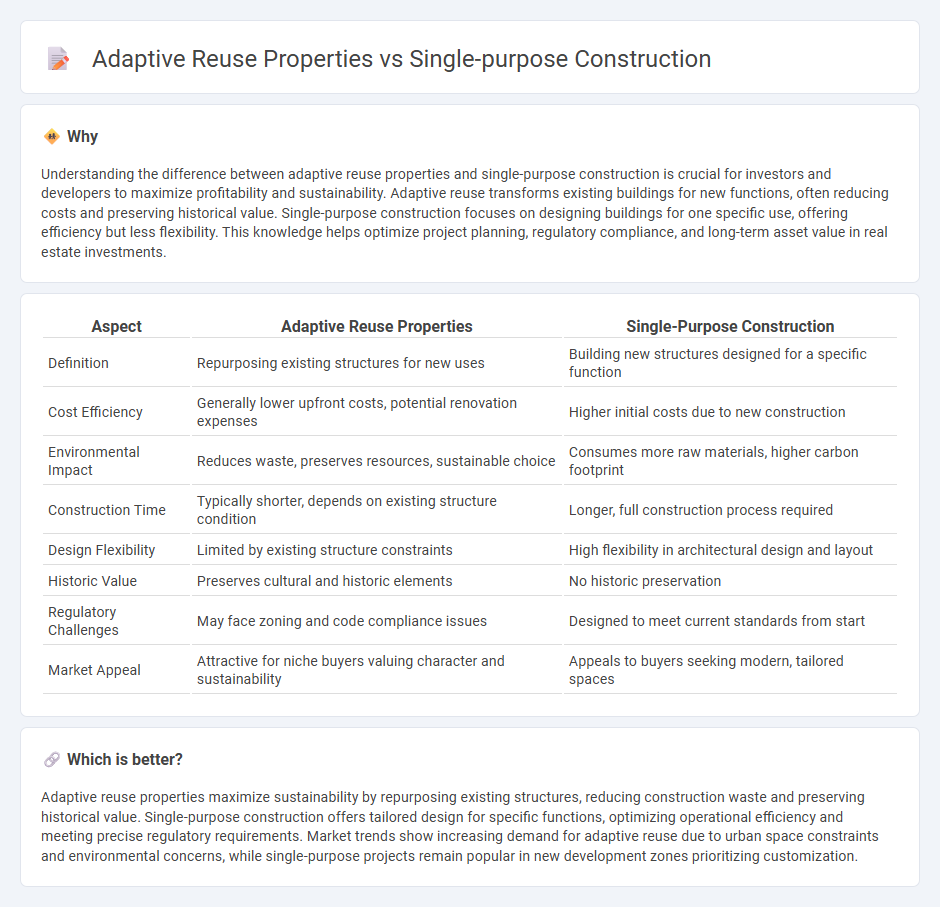
Adaptive reuse properties maximize existing structures by transforming them for new functions, offering sustainability and cost-efficiency benefits compared to single-purpose construction, which is designed exclusively for one use from the ground up. This approach reduces material waste, preserves historical value, and often accelerates project timelines, making it a favored strategy in urban development. Explore how adaptive reuse can reshape real estate opportunities and investment potential.
Why it is important
Understanding the difference between adaptive reuse properties and single-purpose construction is crucial for investors and developers to maximize profitability and sustainability. Adaptive reuse transforms existing buildings for new functions, often reducing costs and preserving historical value. Single-purpose construction focuses on designing buildings for one specific use, offering efficiency but less flexibility. This knowledge helps optimize project planning, regulatory compliance, and long-term asset value in real estate investments.
Comparison Table
| Aspect | Adaptive Reuse Properties | Single-Purpose Construction |
|---|---|---|
| Definition | Repurposing existing structures for new uses | Building new structures designed for a specific function |
| Cost Efficiency | Generally lower upfront costs, potential renovation expenses | Higher initial costs due to new construction |
| Environmental Impact | Reduces waste, preserves resources, sustainable choice | Consumes more raw materials, higher carbon footprint |
| Construction Time | Typically shorter, depends on existing structure condition | Longer, full construction process required |
| Design Flexibility | Limited by existing structure constraints | High flexibility in architectural design and layout |
| Historic Value | Preserves cultural and historic elements | No historic preservation |
| Regulatory Challenges | May face zoning and code compliance issues | Designed to meet current standards from start |
| Market Appeal | Attractive for niche buyers valuing character and sustainability | Appeals to buyers seeking modern, tailored spaces |
Which is better?
Adaptive reuse properties maximize sustainability by repurposing existing structures, reducing construction waste and preserving historical value. Single-purpose construction offers tailored design for specific functions, optimizing operational efficiency and meeting precise regulatory requirements. Market trends show increasing demand for adaptive reuse due to urban space constraints and environmental concerns, while single-purpose projects remain popular in new development zones prioritizing customization.
Connection
Adaptive reuse properties transform existing structures to serve new functions, reducing construction waste and preserving architectural heritage. Single-purpose construction often creates buildings designed for a specific use, making adaptive reuse a valuable strategy when market demands shift and repurposing becomes necessary. Both approaches impact real estate development by balancing sustainability with functionality and market adaptability.
Key Terms
Zoning
Single-purpose construction properties are often governed by strict zoning regulations that define specific land use categories, limiting flexibility in function and design. Adaptive reuse properties benefit from variances or special permits within zoning laws, enabling transformation of existing structures to new uses while preserving historical and architectural value. Explore zoning strategies to optimize property potential and regulatory compliance in diverse urban environments.
Building Codes
Single-purpose construction projects must strictly adhere to contemporary building codes designed for new structures, including updated safety, accessibility, and energy efficiency standards. Adaptive reuse properties face complex challenges integrating existing frameworks with current codes, often requiring variances or special approvals to address legacy elements like structural load and fire resistance. Explore detailed regulatory strategies and compliance solutions for both construction approaches to optimize your project's success.
Functional Obsolescence
Single-purpose construction often faces functional obsolescence quickly due to rigid design tailored for specific uses, limiting adaptability in changing market demands. Adaptive reuse properties mitigate functional obsolescence by repurposing existing structures, enhancing sustainability and preserving architectural value. Explore how adaptive reuse strategies can optimize asset longevity and real estate value in evolving urban landscapes.
Source and External Links
SBA Loan Podcast - What Is A Single-Purpose Property? - ThinkSBA - A single-purpose property is commercial real estate designed and used for a single specific purpose, such as gas stations or churches, and its design limits alternative uses without significant alteration, making it riskier to finance.
Preserving The Single-Purpose Entity For Construction Projects - Single-purpose entities are formed to isolate and limit financial and legal risks of a construction project to that entity alone, protecting parent companies and principals from loss.
Single Purpose Entities in Commercial Real Estate Transactions - A single purpose entity (SPE) is a legal structure, often an LLC or S-corporation, created solely to hold one commercial real estate asset to isolate liabilities and reduce lender risk in financing transactions.
 dowidth.com
dowidth.com